A Forward GPS Multipath Simulator Based on the Vegetation Radiative Transfer Equation Model
Abstract
:1. Introduction
2. Theory and Methodology
2.1. Radiative Transfer Theory
2.2. The Improved Multipath GPS Simulator
3. Model Validation
4. Simulations and Results
4.1. Bare Soil and Wheat Comparisons
4.2. Wheat Moisture Effects
4.3. Vegetation Height Effects
4.4. Ground Soil Moisture Effects
5. Discussion
6. Conclusions
Acknowledgment
Author Contributions
Conflicts of Interest
Abbreviations
| BAO-Tower | Boulder Atmospheric Observatory-tower |
| Bi-Mimics | Bistatic-Michigan Microwave Canopy Scattering Model |
| DBA | distorted Born approximation |
| DMR | Delay Doppler Maps Receiver |
| GNSS | Global Navigation Satellite System |
| GNSS-R | GNSS-Reflectometry |
| GPS | Global Positioning System |
| GPS-IR | GPS-Interferometric Reflectometry |
| GPS-MR | GPS multipath reflectometry |
| LEiMON | Land Monitoring with Navigation Signals |
| LHCP | Left Hand Circular Polarization |
| LR | The polarization of the transmitted signal is RHCP, while the received one is LHCP |
| Mimics | Michigan Microwave Canopy Scattering Model |
| PBO | plate boundary observatory |
| RHCP | Right Hand Circular Polarization |
| RR | The polarization of the transmitted signal is RHCP, while the received one is also RHCP |
| RT | radiative transfer model |
| SMEX | Soil Moisture Experiments |
| SMIGOL | Soil Moisture Interference pattern GNSS Observations at L-band Reflectometer |
| SNR | Signal-to Noise Ratio |
| Spec-Mimics | Specular-Michigan Microwave Canopy Scattering Model |
References
- Jin, S.; Komjathy, A. GNSS reflectometry and remote sensing: New objectives and results. Adv. Space Res. 2010, 46, 111–117. [Google Scholar] [CrossRef]
- Masters, D.; Axelrad, P.; Katzberg, S. Initial results of land-reflected GPS bistatic radar measurements in SMEX02. Remote Sens. Environ. 2004, 92, 507–520. [Google Scholar] [CrossRef]
- Zavorotny, V.; Masters, D.; Gasiewski, A.; Katzberg, S.; Axelrad, P.; Zamora, R. Seasonal polarimetric measurements of soil moisture using tower-based GPS bistatic radar. In Proceedings of the 2003 IEEE International Conference on Geoscience and Remote Sensing Symposium (IGARSS ’03), Toulouse, France, 21–25 July 2003; Volume 2, pp. 781–783. [Google Scholar]
- Egido, A.; Caparrini, M.; Guerriero, L.; Guerriero, L.; Pierdicca, N.; Paloscia, S.; Santi, E.; Brogioni, M. LEiMON Land Monitoring with Navigation Signals; Final Report; ESA Contract 22117/08/NL/AF; ESA/ESTEC: Noordwijk, The Netherlands, 2011. [Google Scholar]
- Pierdicca, N.; Guerriero, L.; Giusto, R.; Brogioni, M.; Egido, A. SAVERS: A Simulator of GNSS Reflections from Bare and Vegetated Soils. IEEE Trans. Geosci. Remote Sens. 2014, 52, 6542–6554. [Google Scholar] [CrossRef]
- Egido, A.; Caparrini, M.; Ruffini, G.; Paloscia, S.; Santi, E.; Guerriero, L.; Pierdicca, N.; Floury, N. Global Navigation Satellite Systems Reflectometry as a Remote Sensing Tool for Agriculture. Remote Sens. 2012, 4, 2356–2372. [Google Scholar] [CrossRef]
- Egido, A.; Paloscia, S.; Motte, E.; Guerriero, L.; Pierdicca, N.; Caparrini, M.; Santi, E.; Fontanelli, G.; Floury, N. Airborne GNSS-R Polarimetric Measurements for Soil Moisture and Above-Ground Biomass Estimation. IEEE J. Sel. Top. Appl. Earth 2014, 7, 1522–1532. [Google Scholar] [CrossRef]
- Rodriguez-Alvarez, N.; Camps, A.; Vall-Llossera, M.; Bosch-Lluis, X.; Monerris, A.; Ramos-Perez, I.; Valencia, E.; Marchan-Hernandez, J.F.; Martinez-Fernandez, J.; Baroncini-Turricchia, G.; et al. Land Geophysical Parameters Retrieval Using the Interference Pattern GNSS-R Technique. IEEE Trans. Geosci. Remote Sens. 2011, 49, 71–84. [Google Scholar] [CrossRef]
- Alonso-Arroyo, A.; Camps, A.; Aguasca, A.; Forte, G.; Monerris, A.; Rüdiger, C.; Walker, J.P.; Park, H.; Pascual, D.; Onrubia, R. Improving the Accuracy of Soil Moisture Retrievals Using the Phase Difference of the Dual-Polarization GNSS-R Interference Patterns. IEEE Trans. Geosci. Remote Sens. Lett. 2014, 11, 2090–2094. [Google Scholar] [CrossRef]
- Chew, C.C.; Small, E.E.; Larson, K.M.; Zavorotny, V.U. Effects of Near-Surface Soil Moisture on GPS SNR Data: Development of a Retrieval Algorithm for Soil Moisture. IEEE Trans. Geosci. Remote. Sens. 2014, 52, 537–543. [Google Scholar] [CrossRef]
- Larson, K.M.; Nievinski, F.G. GPS snow sensing: Results from the EarthScope Plate Boundary Observatory. GPS Solut. 2013, 17, 41–52. [Google Scholar] [CrossRef]
- Chew, C.C.; Small, E.E.; Larson, K.M.; Zavorotny, V.U. Vegetation Sensing Using GPS-Interferometric Reflectometry: Theoretical Effects of Canopy Parameters on Signal-to-Noise Ratio Data. IEEE Trans. Geosci. Remote Sens. 2015, 53, 2755–2764. [Google Scholar] [CrossRef]
- Nievinski, F.G.; Larson, K.M. Forward modeling of GPS multipath for near-surface reflectometry and positioning applications. GPS Solut. 2013, 18, 309–322. [Google Scholar] [CrossRef]
- Nievinski, F.G.; Larson, K.M. An open source GPS multipath simulator in Matlab/Octave. GPS Solut. 2014, 18, 1–9. [Google Scholar] [CrossRef]
- Zavorotny, V.U.; Larson, K.M.; Braun, J.J.; Small, E.E.; Gutmann, E.D.; Bilich, A.L. A Physical Model for GPS Multipath Caused by Land Reflections: Toward Bare Soil Moisture Retrievals. IEEE J. Sel. Top. Appl. Earth 2010, 3, 100–110. [Google Scholar] [CrossRef]
- Liang, P.; Pierce, L.E.; Moghaddam, M. Radiative transfer model for microwave bistatic scattering from forest canopies. IEEE Trans. Geosci. Remote Sens. 2005, 43, 2470–2483. [Google Scholar] [CrossRef]
- Ulaby, F.T.; Sarabandi, K.; Mcdonald, K.; Whitt, M.; Dobson, M.C. Michigan Microwave Canopy Scattering Models. Int. J. Remote Sens. 1990, 11, 1223–1253. [Google Scholar] [CrossRef]
- Small, E.E.; Larson, K.M.; Braun, J.J. Sensing vegetation growth with reflected GPS signals. Geophys. Res. Lett. 2010, 37, 245–269. [Google Scholar] [CrossRef]
- Ulaby, F.T.; Elachi, C. Radar Polarimetry for Geoscience Applications; Artech House Inc.: Norwood, MA, USA, 1990. [Google Scholar]
- Hallikainen, M.T.; Ulaby, F.T.; Dobson, M.C.; El-Rayes, M.A.; Wu, L.K. Microwave Dielectric Behavior of Wet Soil—Part 1: Empirical Models and Experimental Observations. IEEE Trans. Geosci. Remote Sens. 1985, GE-23, 25–34. [Google Scholar] [CrossRef]
- Dobson, M.C.; Ulaby, F.T.; Hallikainen, M.T.; El-Rayes, M.A. Microwave Dielectric Behavior of Wet Soil-Part II: Dielectric Mixing Models. IEEE Trans. Geosci. Remote Sens. 1985, GE-23, 35–46. [Google Scholar] [CrossRef]
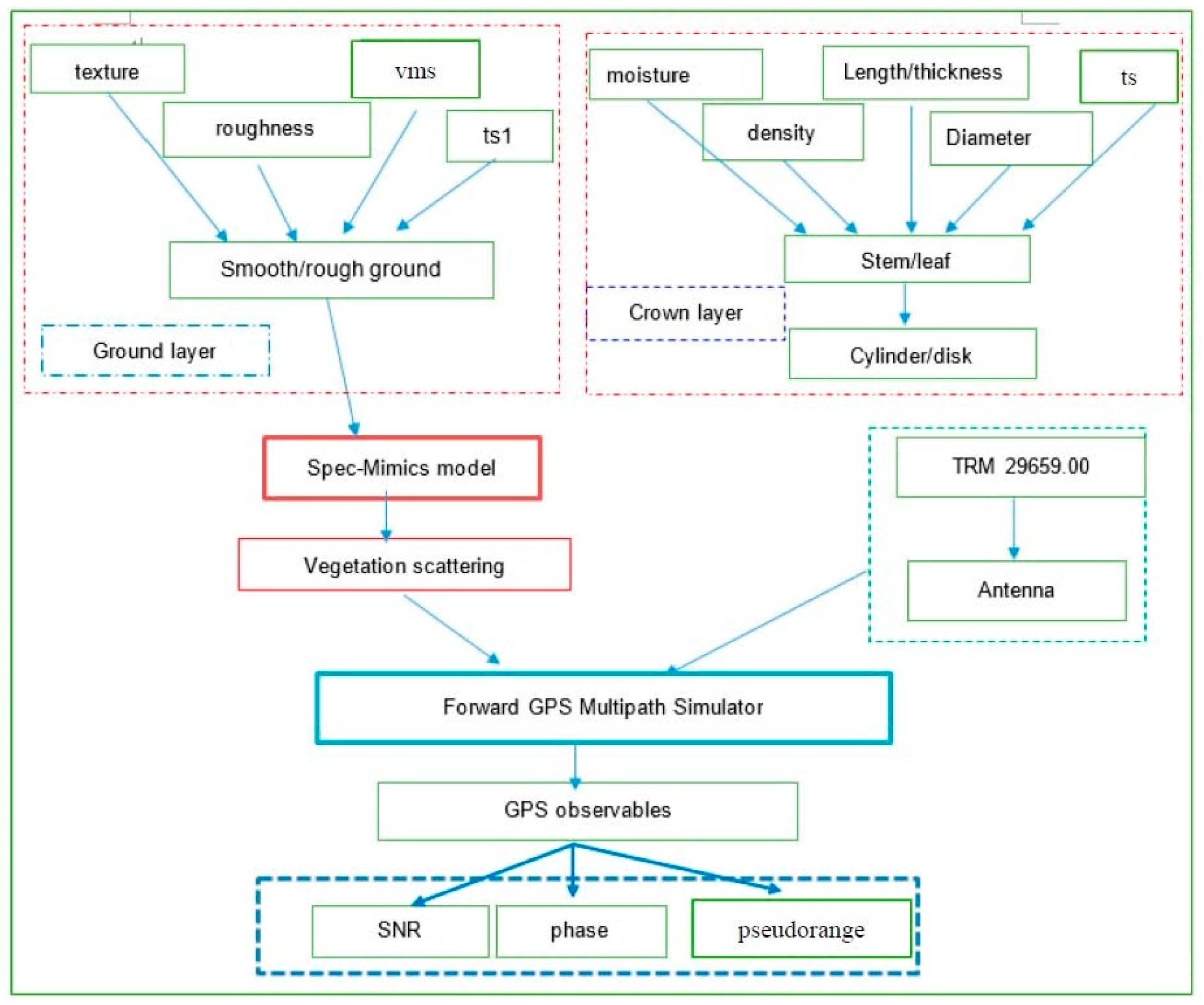
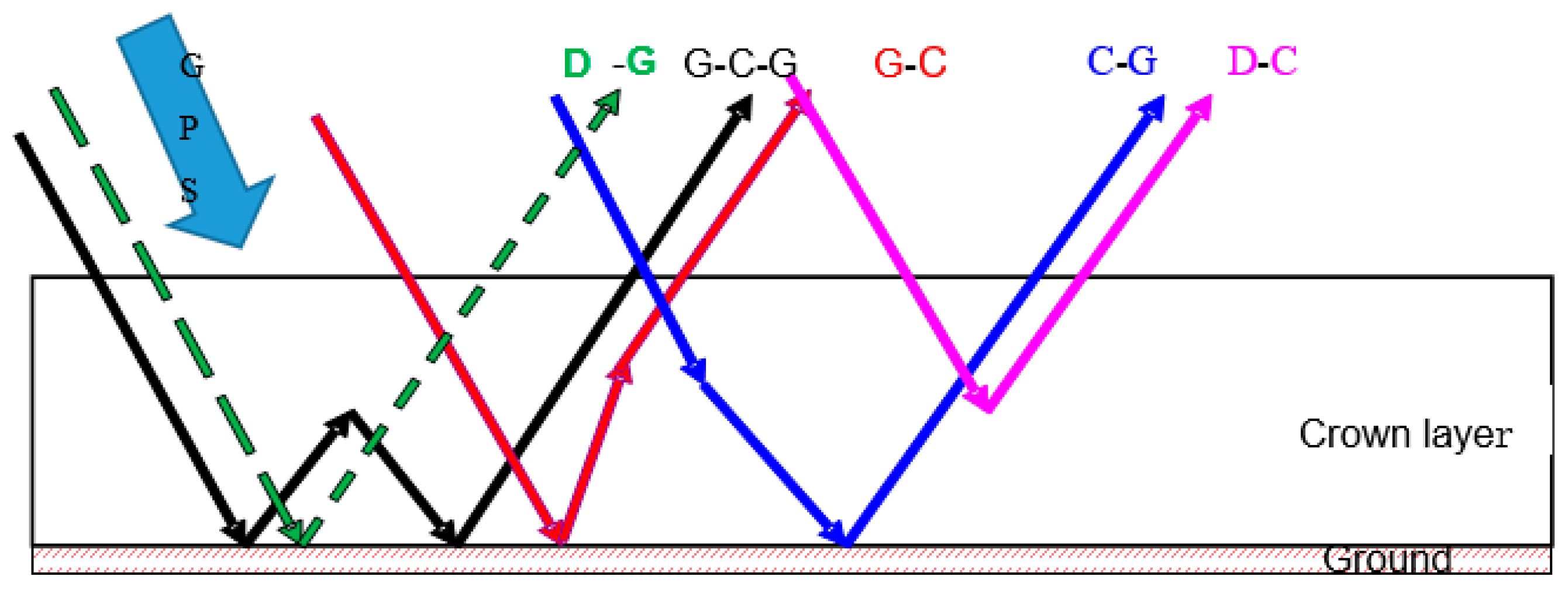

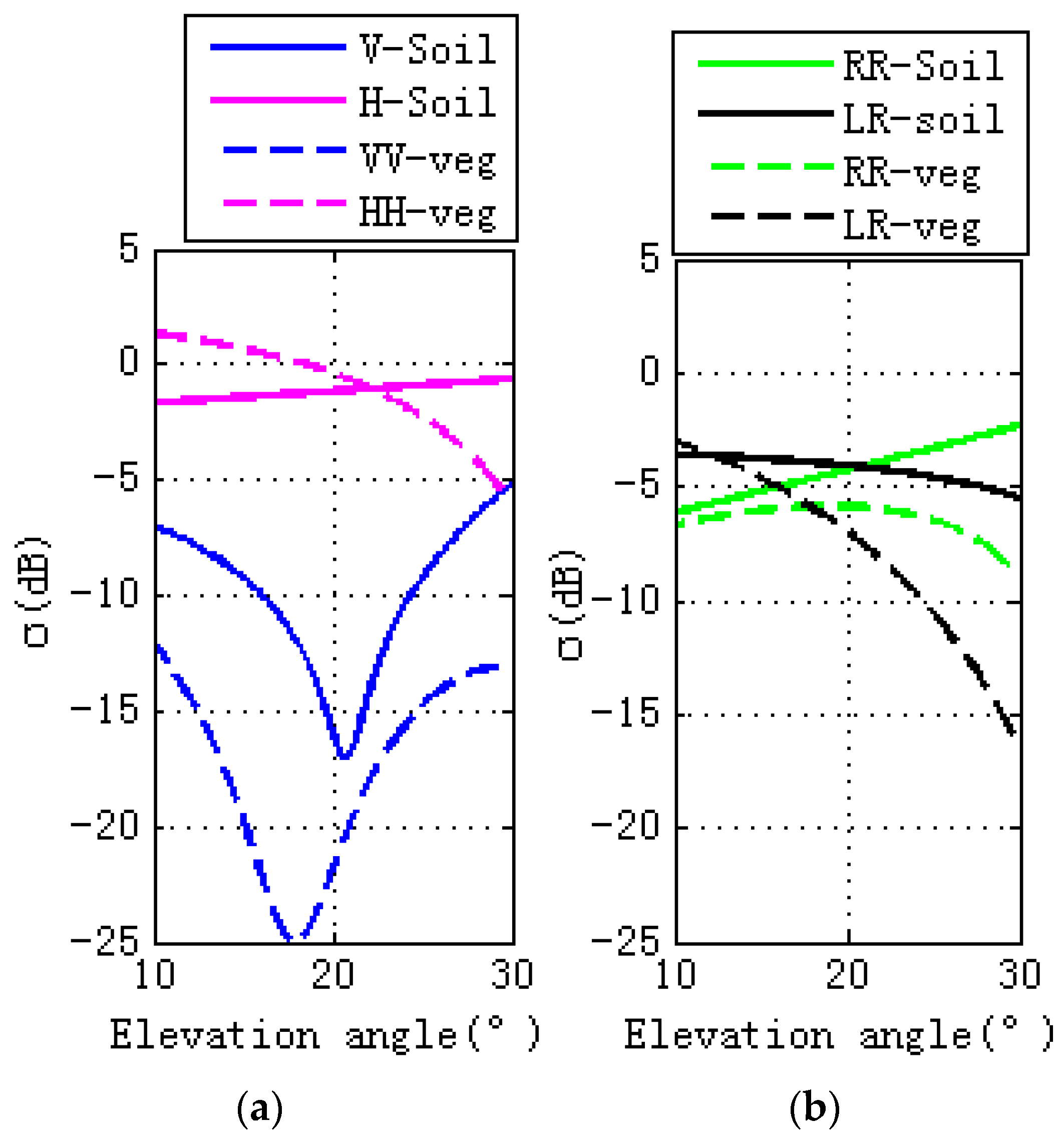
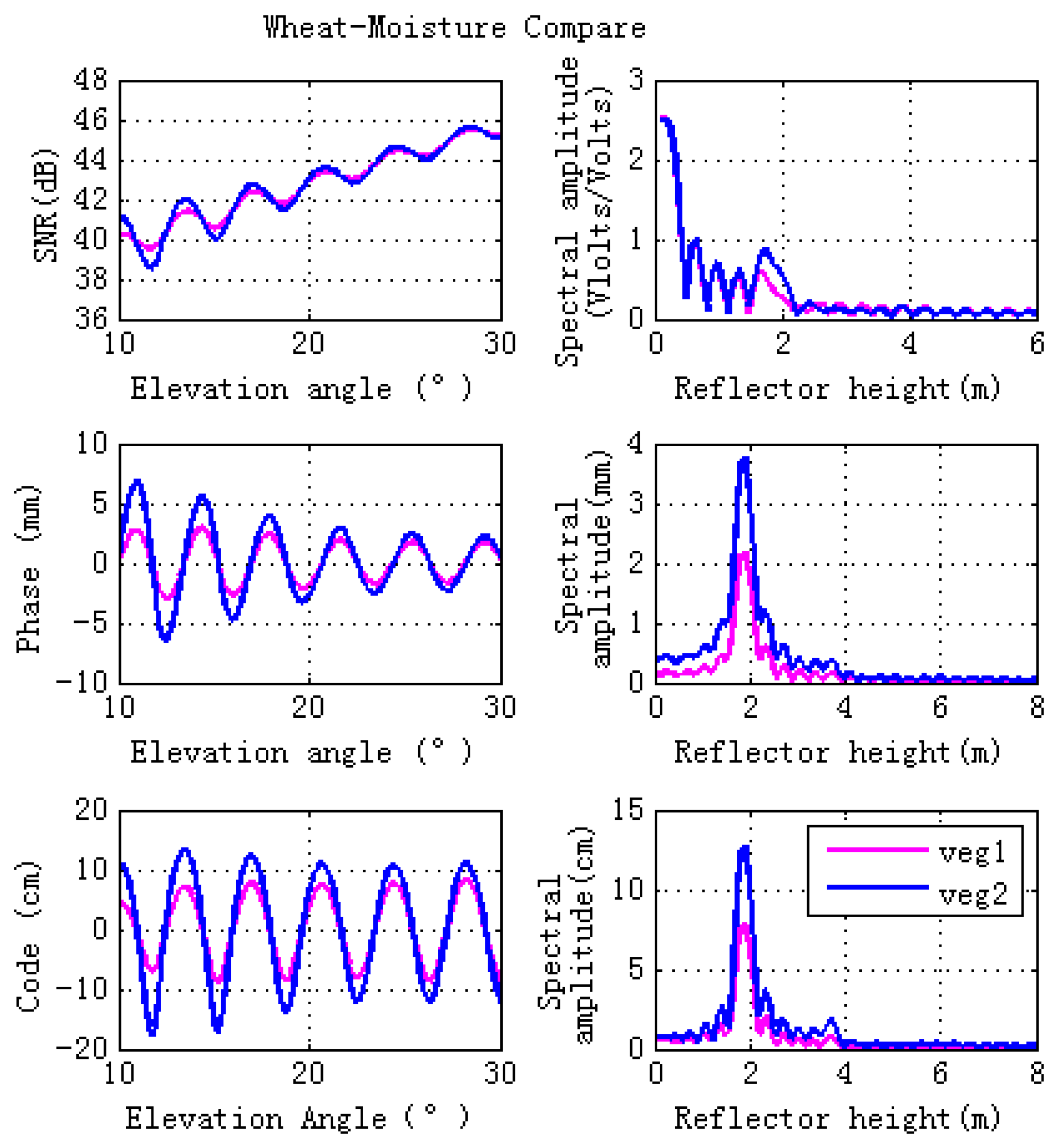
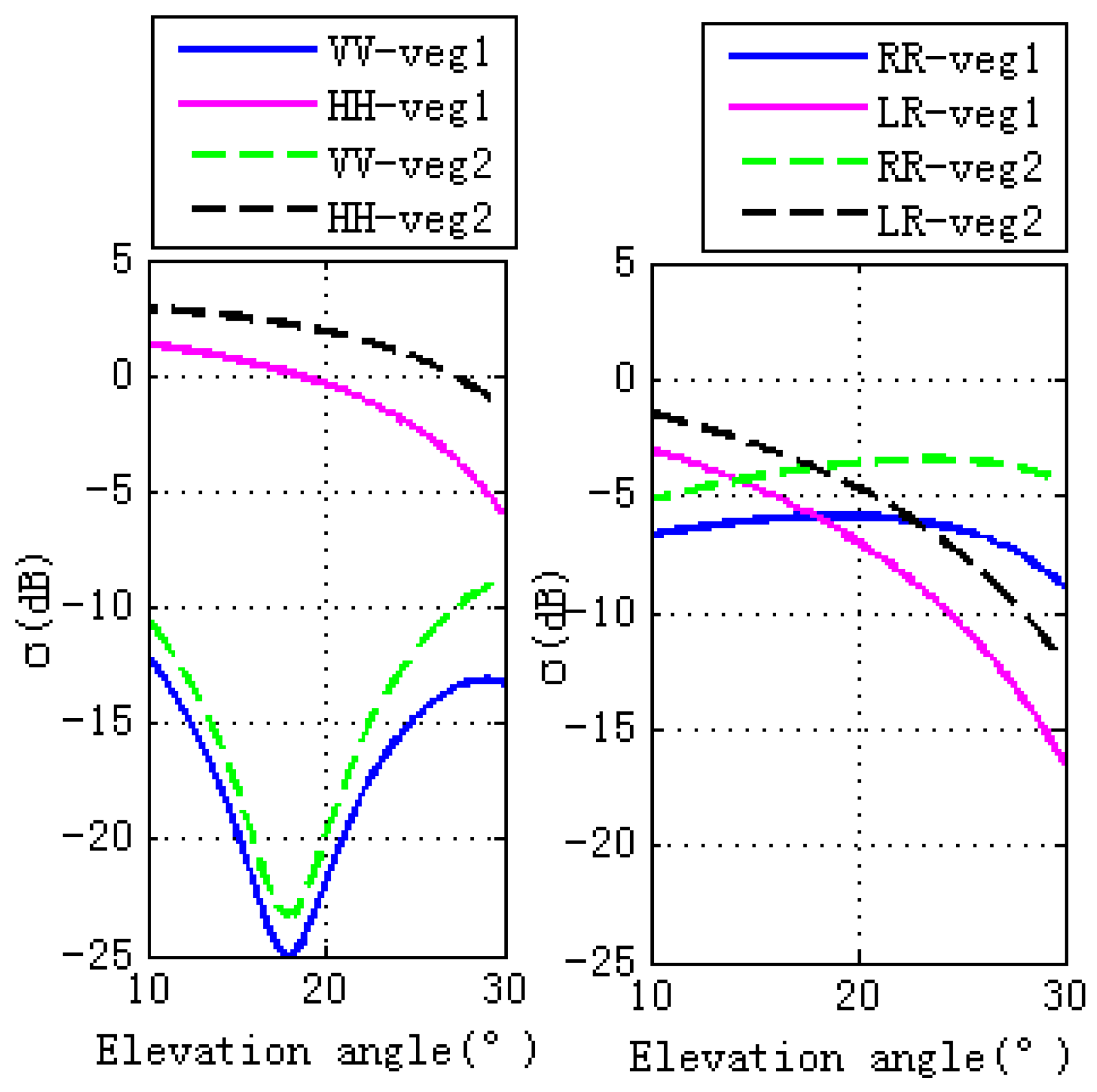
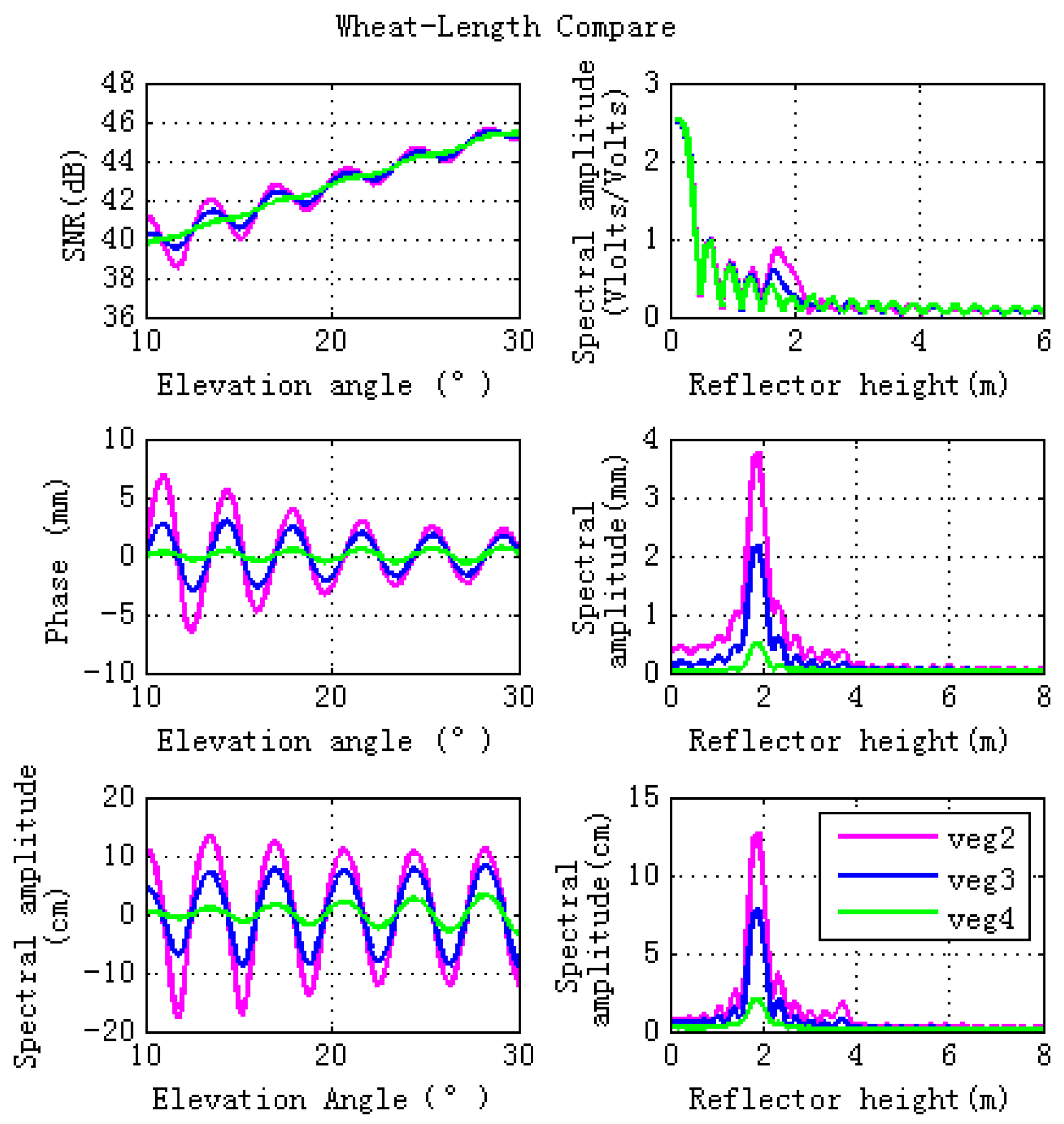
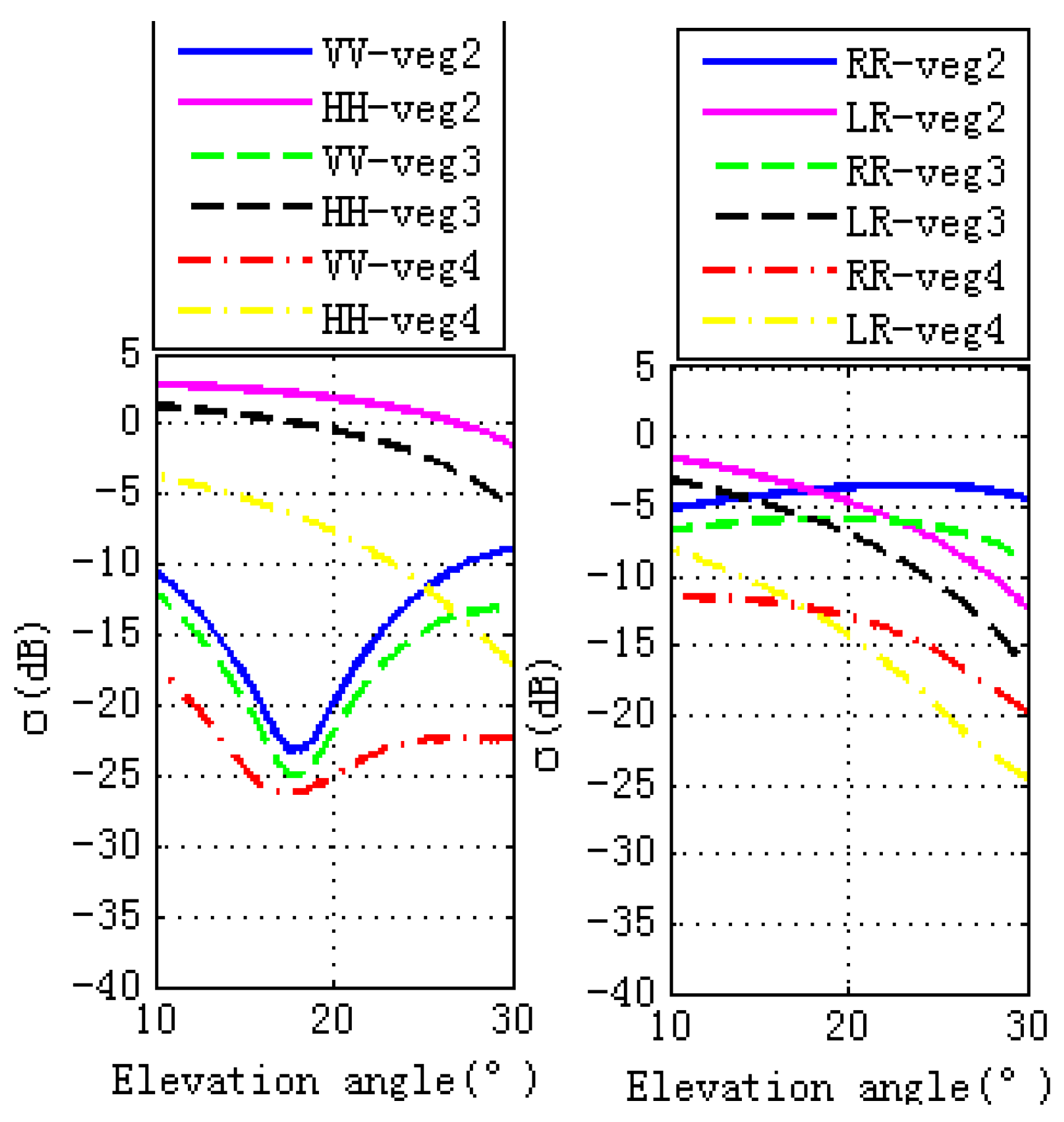
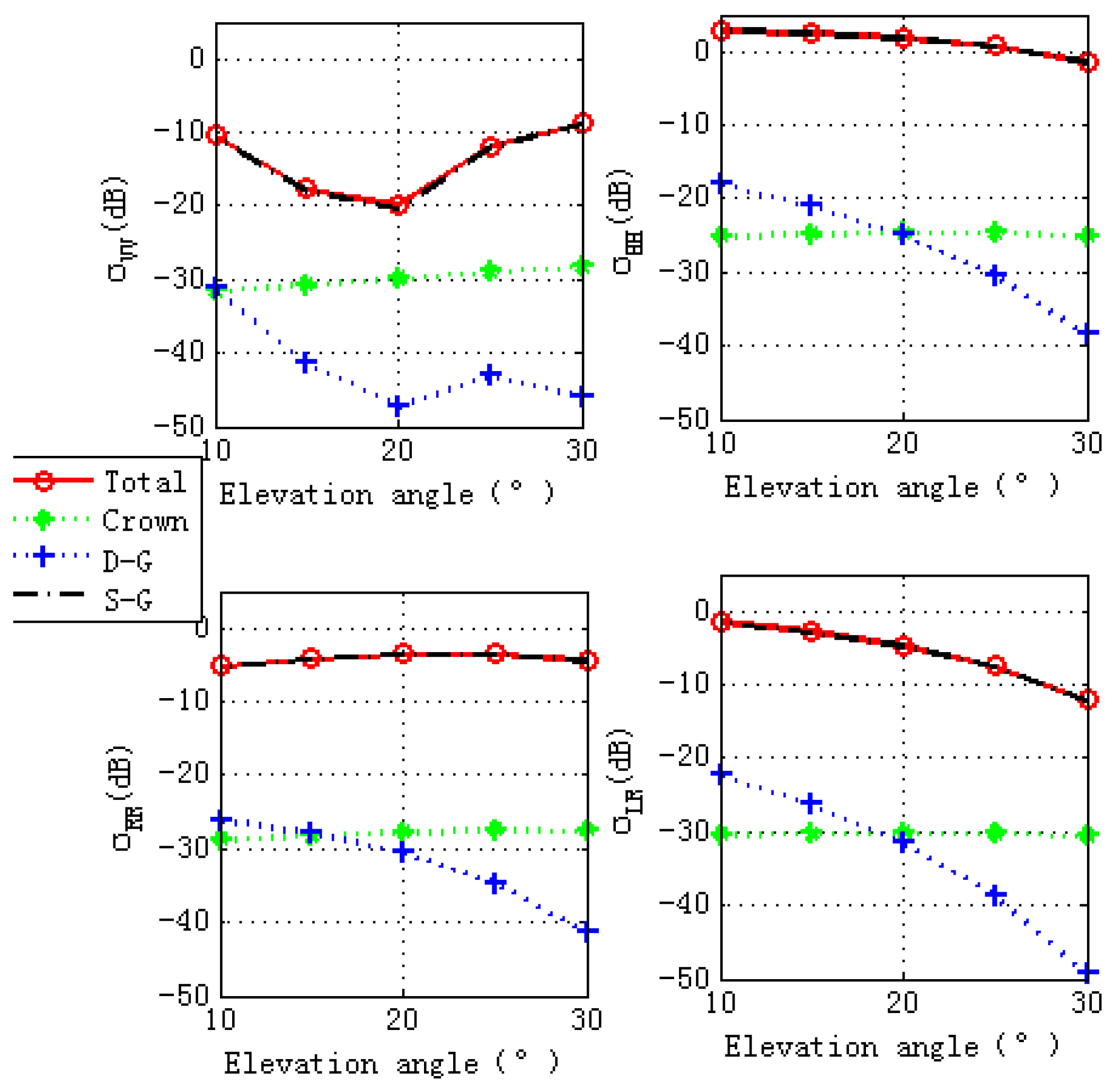
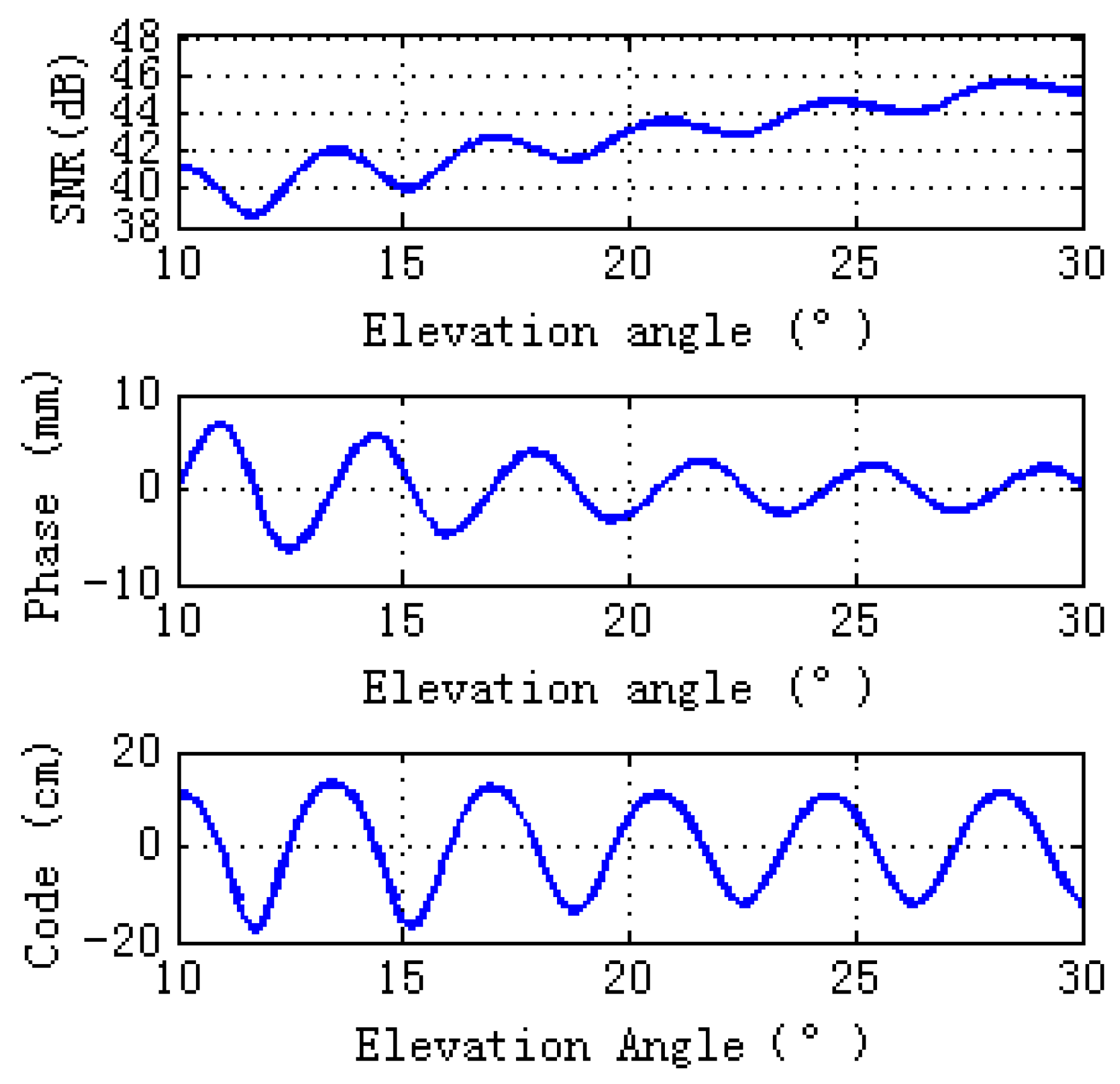
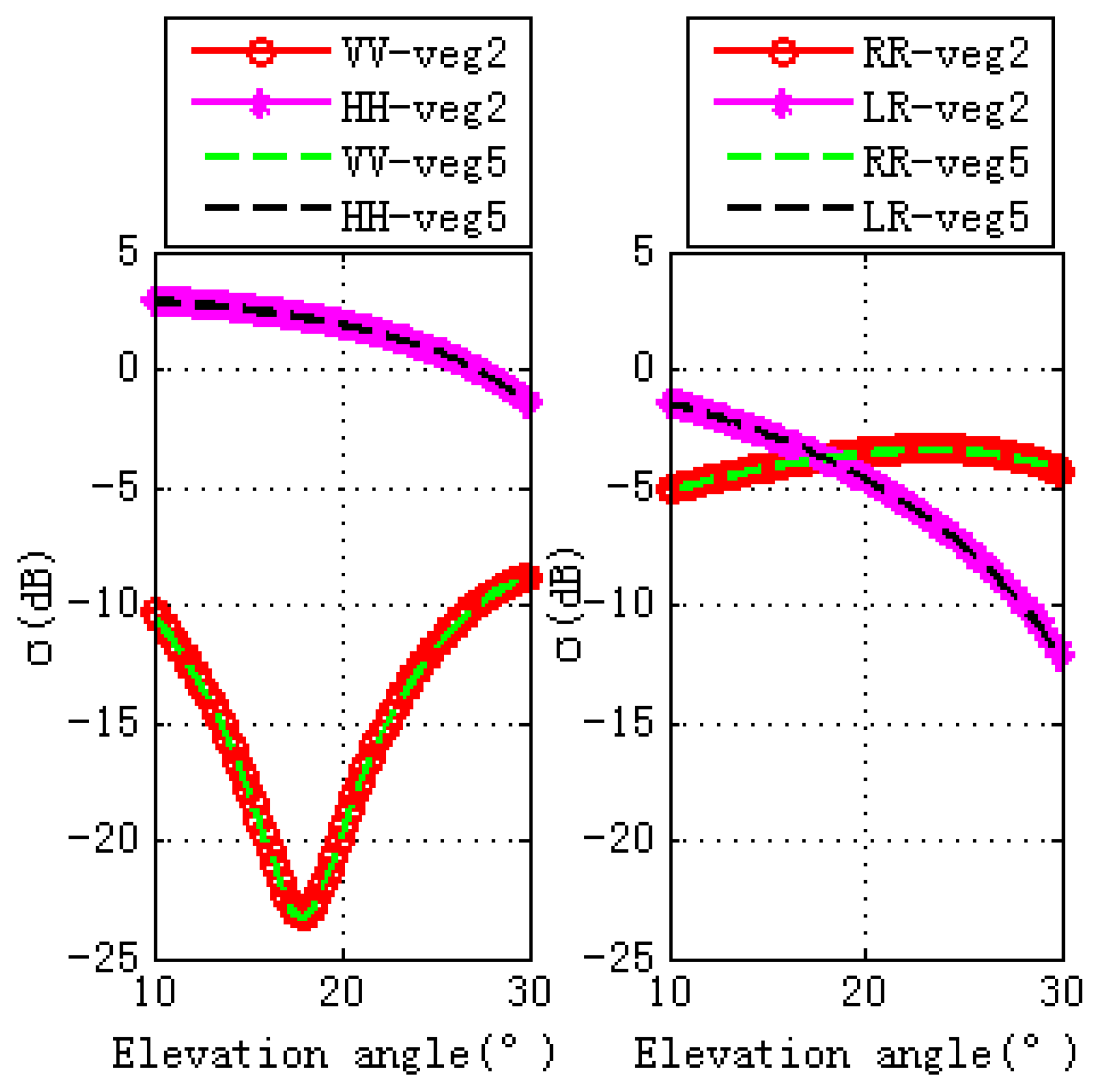
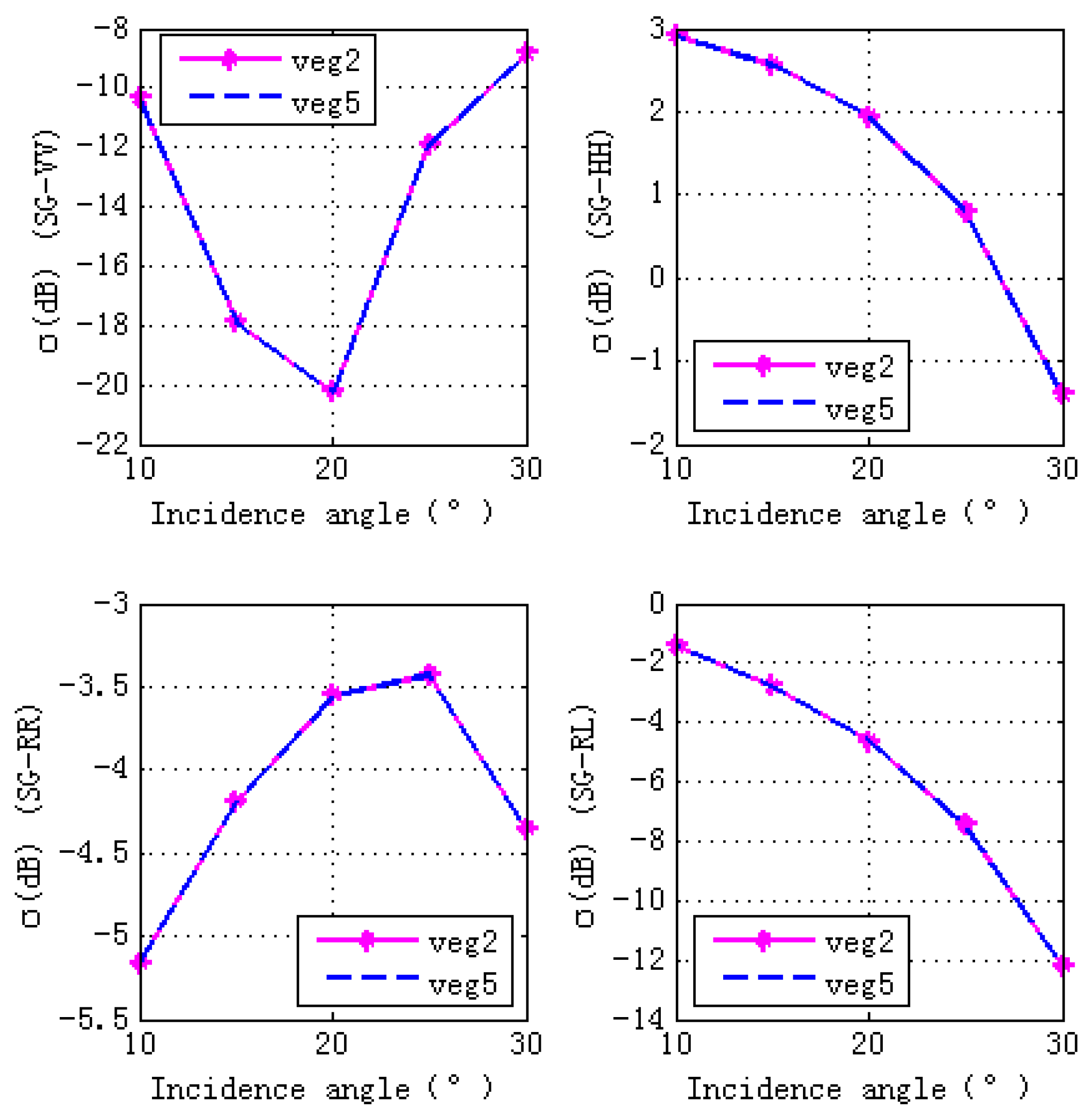
| Stem | Leaf | Ground | |||
|---|---|---|---|---|---|
| Moisture (gravimetric) | 0.72 | Moisture (gravimetric) | 0.8 | Soil RMS Height (cm) | 0.45 |
| Density (number/m3) | 1000 | Density (number/m3) | 2500 | Correlation length (cm) | 18.75 |
| Length (m) | 0.35 | Thickness (m) | 0.02 | Moisture (volumetric) | 0.15 |
| Diameter (cm) | 0.3 | Diameter (cm) | 0.04 | Soil % sand | 10 |
| Temperature (°C) | 20 | Temperature (°C) | 20 | Temperature (°C) | 20 |
| Distribution | Uniform | Distribution | Uniform | Soil % silt | 60 |
| Vegetation 1 | |||
| Stem | Leaf | ||
| Moisture(gravimetric) | 0.72 | Moisture(gravimetric) | 0.8 |
| Vegetation 2 | |||
| Stem | Leaf | ||
| Moisture(gravimetric) | 0.2 | Moisture(gravimetric) | 0.2 |
| Vegetation 2 | ||||
| Stem | Leaf | |||
| length (m) | 0.15 | thickness (m) | 0.01 | |
| diameter (cm) | 0.3 | diameter (cm) | 0.02 | |
| Vegetation 3 | ||||
| Stem | Leaf | |||
| length (m) | 0.35 | thickness (m) | 0.02 | |
| diameter (cm) | 0.3 | diameter (cm) | 0.04 | |
| Vegetation 4 | ||||
| Stem | Leaf | |||
| length (m) | 0.55 | length (m) | 0.04 | |
| diameter (cm) | 0.4 | diameter (cm) | 0.05 | |
| Ground (Volumetric Soil Moisture) | |
|---|---|
| Vegetation 2 | 0.15 |
| Vegetation 5 | 0.55 |
© 2017 by the authors. Licensee MDPI, Basel, Switzerland. This article is an open access article distributed under the terms and conditions of the Creative Commons Attribution (CC BY) license (http://creativecommons.org/licenses/by/4.0/).
Share and Cite
Wu, X.; Jin, S.; Xia, J. A Forward GPS Multipath Simulator Based on the Vegetation Radiative Transfer Equation Model. Sensors 2017, 17, 1291. https://doi.org/10.3390/s17061291
Wu X, Jin S, Xia J. A Forward GPS Multipath Simulator Based on the Vegetation Radiative Transfer Equation Model. Sensors. 2017; 17(6):1291. https://doi.org/10.3390/s17061291
Chicago/Turabian StyleWu, Xuerui, Shuanggen Jin, and Junming Xia. 2017. "A Forward GPS Multipath Simulator Based on the Vegetation Radiative Transfer Equation Model" Sensors 17, no. 6: 1291. https://doi.org/10.3390/s17061291






